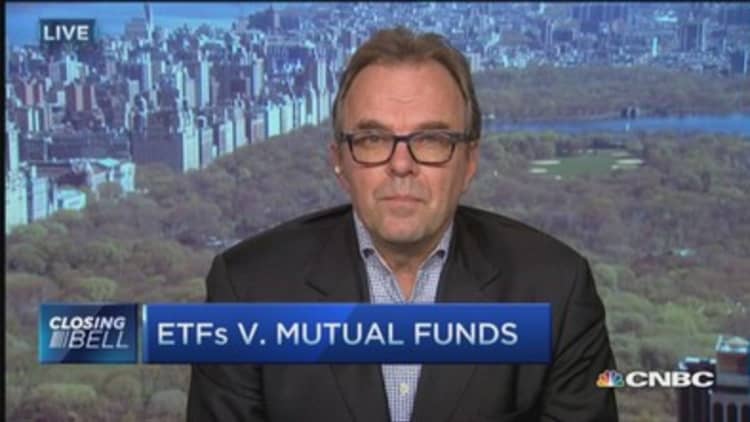
Exchange-traded funds have surged in popularity in 2015, but it's not U.S. equities that are leading the charge.
Investors poured $97.2 billion into various ETFs and other similar products in the first quarter, marking the $2.9 trillion industry's biggest start ever despite a wobbly U.S. stock market and a testy geopolitical climate, according to data from BlackRock, the world's largest provider of such funds. (U.S.-based ETFs have about $2.1 trillion in assets.)
There essentially have been three major investment themes this year, and players in the exchange-traded market have made each work: A quest for investment themes outside the U.S.; the offshoot of that, which has seen domestic attention turn away from large caps and toward mid- and small-sized companies, and capitalizing on the big moves in currency markets, particularly an appreciation of the U.S. dollar and the decline of its global competitors. The greenback has gained 7 percent so far against a trade-weighted basket of other leading currencies.
Some $59 billion has found its way into products that focus on currency hedging, according to ETF.com, which said the group represented four or the top 10 funds for investor flows during the first three months of the year.
Other big developments in March saw investors clamoring for developed international markets, with $14.8 billion flowing to European funds and $8.3 billion to Japanese equities. U.S.-focused funds trailed, with $6.2 billion in inflows, according to BlackRock.
In total, the month saw $32.6 billion go to non-U.S. developed markets, a total that matched the previous two months combined and was especially remarkable considering that 2014 closed with a huge run toward U.S. equities. The fourth quarter saw total inflows to all exchange-traded products at a record $138 billion, with the largest focus toward domestic large-cap.
Top 5 ETF inflows in 2015
| Fund | Ticker | Inflows (in $billion, through 4/2/15) |
|---|---|---|
| Wisdom Tree Europe Hedged Equity | HEDJ | $10.59 |
| Deutsche X-trackers MSCI EAFE Hedged Equity | DBEF | $5.71 |
| Vanguard Total Stock Market | VTI | $3.66 |
| Vanguard S&P 500 | VOO | $2.85 |
| iShares iBoxx $ Investment Grade Corporate Bond | LQD | $2.81 |
Source: Source: ETF.com
Top ETF Outflows of 2015
| Fund | Ticker | Outflows (in billion$, as of 4/2/15) |
|---|---|---|
| SPDR S&P 500 | SPY | $34.35 |
| iShares MSCI Emerging Markets | EEM | $3.17 |
| PowerShares QQQ | QQQ | $3.13 |
| Financial Select SPDR | XLF | $2.65 |
| Consumer Staples Select SPDR | XLP | $1.95 |
Source: Source: ETF.com
2015 has brought a different environment, however.
Investors have been spooked by the prospect of the Federal Reserve raising interest rates, a markedly lower outlook for S&P 500 corporate profits and a U.S. economy likely to barely register positive gross domestic product growth in the first quarter. The Atlanta Fed's GDPNow tracker has Q1 growth at just 0.1 percent.
Market participants are adjusting to the new conditions in a variety of ways, with currency hedging the most popular.
For instance, the Wisdom Tree Europe Hedged Equity Fund, which has attracted $10.6 billion in new money year to date, has gained 20.1 percent in price, multiples higher than most any U.S.-focused stock or bond index, as it has helped investors navigate the sagging euro. The fund looks for dividend-paying companies that derive half or more of their sales outside the euro zone—with the notion that these types of companies will perform well under a cheaper euro.
The danger, of course, is that the fund would get hit especially hard should the euro turn course, but that is an unlikely eventuality now that the European Central Bank is in the early stages of Fed-style quantitative easing, and as the U.S. central bank looks to tighten its monetary policy and push the dollar higher.
Similarly, the ($2.7 billion inflows YTD), follows a complicated strategy that at its core is based on Abenomics—policies espoused by Japanese Prime Minister Shinzo Abe, who also has taken his country down the aggressive QE path. The fund concentrates on exporters—primary holdings are Toyoto Motor, Mitsubishi and Canon—that pay dividends and provide exposure to a falling yen. The DXJ is up 12.5 percent year to date.
Investors also have gotten smaller this year.
Large-cap U.S. funds have surrendered $28.6 billion, while mid-caps have pulled in a net $4.8 billion and small and micro caps have taken in $3.3 billion on net. In terms of sectors, energy funds have been the most popular, with inflows of $4.8 billion, while utilities have been the biggest loser, giving up $2.2 billion, according to BlackRock.
Flows have followed performance: The , which focuses on U.S. large caps, is up just 1.1 percent year to date, while the , which tracks nonlarge caps, has gained 4.6 percent.
The move overall into ETFs has come amid an increasing vocal debate over active against passive management. ETFs are mostly passive funds that track basic indexes, while mutual funds are mostly active and thus more prone to move in and out of positions. ETFs are traded like stocks and have lower fees than mutual funds.
In recent years, active management has badly lagged market benchmarks. Conditions have improved somewhat this year, though, with 44 percent now topping the indexes against which they are measured, according to Bank of America Merrill Lynch.




